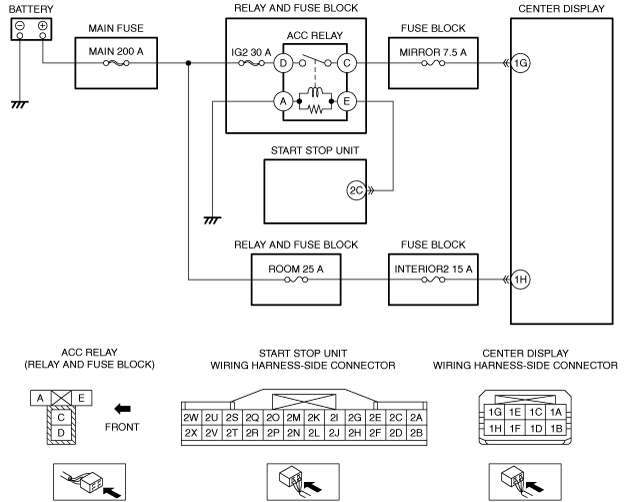|
1
|
VERIFY PCM DTCs
• Retrieve the PCM DTCs using the M-MDS.
• Are any DTCs displayed?
|
Yes
|
Repair or replace the malfunctioning part according to the applicable DTC troubleshooting.
|
|
No
|
Go to the next step.
|
|
2
|
INSPECT BATTERY
• Is the battery normal?
|
Yes
|
Go to the next step.
|
|
No
|
Recharge or replace the battery, then go to Step 8.
|
|
3
|
INSPECT GENERATOR
• Is the generator normal?
|
Yes
|
Go to the next step.
|
|
No
|
Replace the generator, then go to Step 8.
|
|
4
|
INSPECT CENTER DISPLAY CONNECTOR CONDITION
• Switch the ignition off.
• Disconnect the negative battery terminal.
• Disconnect the center display connector.
• Inspect the connector engagement and connection condition and inspect the terminals for damage, deformation, corrosion, or disconnection.
• Is the connector normal?
|
Yes
|
Go to the next step.
|
|
No
|
Repair or replace the connector, then go to Step 8.
|
|
5
|
VERIFY CENTER DISPLAY B+ POWER SUPPLY VOLTAGE
• Connect the negative battery terminal.
• Measure the voltage at center display terminal 1H (wiring harness-side).
• Is the voltage B+?
|
Yes
|
Go to the next step.
|
|
No
|
Inspect the INTERIOR2 15 A fuse and ROOM 25 A fuse.
• Any fuse is blown:
-
? Refer to the wiring diagram and verify if there is a common connector between MAIN 200 A fuse and center display terminal 1H.
If there is a common connector:
-
• Determine the malfunctioning part by inspecting the common connector and the terminal for corrosion, damage, or pin disconnection, and the common wiring harness for a short to ground.
• Repair or replace the malfunctioning location.
If there is no common connector:
-
• Repair or replace the wiring harness which has a short to ground.
• Replace the fuse.
• Any fuse is damaged:
-
? Replace the fuse.
• All fuses are normal:
-
? Refer to the wiring diagram and verify if there is a common connector between positive battery terminal and center display terminal 1H.
If there is a common connector:
-
• Determine the malfunctioning part by inspecting the common connector and the terminal for corrosion, damage, or pin disconnection, and the common wiring harness for an open circuit.
• Repair or replace the malfunctioning location.
If there is no common connector:
-
• Repair or replace the wiring harness which has an open circuit.
Go to Step 8.
|
|
6
|
VERIFY CENTER DISPLAY ACC POWER SUPPLY VOLTAGE
• Switch the ignition to ACC.
• Measure the voltage at center display terminal 1G (wiring harness-side).
• Is the voltage B+?
|
Yes
|
Go to the next step.
|
|
No
|
Inspect the MIRROR 7.5 A fuse.
• If the fuse is blown:
-
? Refer to the wiring diagram and verify if there is a common connector between MIRROR 7.5 A fuse and center display terminal 1G.
If there is a common connector:
-
• Determine the malfunctioning part by inspecting the common connector and the terminal for corrosion, damage, or pin disconnection, and the common wiring harness for a short to ground.
• Repair or replace the malfunctioning location.
If there is no common connector:
-
• Repair or replace the wiring harness which has a short to ground.
• Replace the fuse.
• If the fuse is damaged:
-
? Replace the fuse.
• If the fuse is normal:
-
? Refer to the wiring diagram and verify if there is a common connector between ACC relay terminal C and center display terminal 1G.
If there is a common connector:
-
• Determine the malfunctioning part by inspecting the common connector and the terminal for corrosion, damage, or pin disconnection, and the common wiring harness for an open circuit.
• Repair or replace the malfunctioning location.
If there is no common connector:
-
• Repair or replace the wiring harness which has an open circuit.
Go to Step 8.
|
|
7
|
VERIFY IF MALFUNCTIONING LOCATION IS CENTER DISPLAY DEPENDING ON REPEATABILITY
• Clear the DTC for the connectivity master unit (CMU) using the M-MDS.
• Switch the ignition ON (engine off or on) and wait for 12 s or more.
• Retrieve the connectivity master unit (CMU) DTCs using the M-MDS.
• Is the same DTC displayed?
|
Yes
|
Replace the center display, then go to the next step.
|
|
No
|
Go to Step 9.
|
|
8
|
VERIFY THAT REPAIRS HAVE BEEN COMPLETED
• Always reconnect all disconnected connectors.
• Connect the negative battery terminal.
• Clear the DTC for the connectivity master unit (CMU) using the M-MDS.
• Switch the ignition ON (engine off or on) and wait for 12 s or more.
• Retrieve the connectivity master unit (CMU) DTCs using the M-MDS.
• Is the same DTC displayed?
|
Yes
|
Repeat the inspection from Step 1.
• If the malfunction recurs, replace the connectivity master unit (CMU).
Go to the next step.
|
|
No
|
Go to the next step.
|
|
9
|
VERIFY IF OTHER DTCs DISPLAYED
• Are any other DTCs displayed?
|
Yes
|
Repair or replace the malfunctioning part according to the applicable DTC troubleshooting.
|
|
No
|
DTC troubleshooting completed.
|
